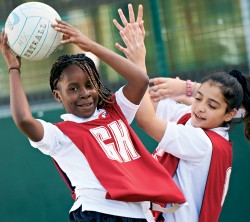School profile
Location: Islington
Pupils: 800
During the first half of the autumn term at Holloway School, Islington, there is an open invitation for prospective new parents to come and visit the place with their offspring. There's no need to book – you just turn up any morning at 9.00am expressing an interest, and Bob Hamlyn, the head teacher, will take you round the entire site, opening doors onto classrooms, encouraging interaction with teachers and students, and maintaining a constant, cheery patter that falls just the right side of a hard sell as he describes the school of which he is clearly extremely proud.
"If you don't choose me, I won't be upset," he says. "But I will be upset if you don't come and see me in the first place."
I know this is what happens, because when my photographer and I arrive for our own look at Holloway School, we are able to piggyback onto one of Bob's so-called 'head teacher's tours', as he shows a mother and her ten-year-old son around one of the two schools they are considering for him next year. She is perhaps a little nervous at first, and I definitely sense a hint of negative prejudice, but she knows what she wants and is full of pertinent questions about how her child's specific needs (he has dyspraxia, and is gifted at sports) might be addressed at Holloway, all of which are dealt with by Bob with convincing, reassuring authority. By the end of the visit, which takes maybe fifteen minutes or so, she is openly impressed.
"I had quite a few reservations," she admits, when I ask her if the visit has changed her mind about anything. "This place has had quite a bad reputation, and someone I spoke to, who is in education, said it's not as good as other school we're considering. But coming here… it's not just the sports [Holloway is a specialist sports college, with excellent facilities including a swimming pool and fully equipped workout gym], but it's seeing the kids in the classes. They're not… rowdy. It reminds me of my own school; and I really like that."
I ask her son, who has been silent but interested throughout, what he liked best.
"The swimming pool!" he replies instantly, with the first flash of a smile he's shown all morning. He has a point – it's superb – but I know what his mum means, too, and after they have left and Bob and I are back in his office, I try and find out more about how he and his team have developed the calm, engaged, and yes, happy atmosphere of teaching and learning that both the prospective parent and I have just observed across all age groups, in a school that up until seven or eight years ago was by all accounts 'challenging' at best, and worryingly chaotic at worst.

The vision Bob brought with him to Holloway from his previous school in Sheffield, where he had been deputy head, was one of excellence.
"I said in the first staff meeting that I wanted to raise expectations," he points out. "I was determined to make everyone realise that you can aspire to excellence in a mainstream comprehensive, and not at the expense of equality, equity and inclusion, either. When you look at the tables, we're on the highest indicator for everything – SEN, free school meals, overcrowded households, EAL – but that's irrelevant within these walls. We have a strong sense of community, but the young people leave the street stuff, if I can call it that, at the gates. There are no hoodies, no mobile phones, no bangles or bandanas. They're here to learn, and be happy, in a safe, secure, calm place. With the best will in the world, we can't fix everything that goes on outside the school, but we can make school a place they want to be (our PAs are down from 118 four years ago, to around 19 now, |thanks to a highly proactive programme aimed at improving attendance through positive reinforcement), and where they can concentrate on achieving everything of which they are capable."
At this point in our conversation, I realise something that I'd noticed earlier, but not really registered – the girls don't even wear make-up. None of them. It's quite a revelation to me just what a difference this makes; it's a real leveller, somehow, with natural, youthful beauty not confined merely to those with the most expensive cosmetics collection.
"That was a bit of a battle," confirms assistant head teacher Julie Griffith, when I talk to her about it later on. "But it's important. We had girls of 13 or 14 saying they 'couldn't leave the house without their mascara and lipgloss', and we were not prepared to accept that.. They don't need that kind of pressure on top of everything else, and I think that now, they really appreciate just being able to be themselves, not having to try and compete to look most like something out of a celebrity magazine."
Alongside the gradual but relentless change in culture, replacing lethargy and discord with aspiration and mutual respect, Bob's time as head teacher at Holloway has also seen a dramatic improvement in the physical structure of the school, which benefited from the first wave of the previous government's BSF programme, and now comprises a fantastic £20 million development, all pale wood cladding and great expanses of glass, which blends beautifully with the elegant, refurbished Edwardian buildings that remain, along with state of the art equipment including a suite of Apple Macs as well as plenty of PCs, and a collection of electronic keyboards that enable every pupil to learn to play.

The more Bob describes how much has altered during his time as head teacher – including moving from accepting boys only to being co-ed, and being granted specialist school status as a sports college in 2005 – the more I understand why he devotes so much time to interacting with prospective parents (as well as the daily morning tours, there are evening presentations, and a more or less open doors policy generally, as far as practicalities allow). 'Reputation' is a powerful thing, and to many local residents, Holloway's old image, of a school which was more about damage limitation than actually supporting students' learning and maximising their future life chances, still hangs over the smart, new buildings like a smokescreen, distorting the reality of what is happening inside. Anything that connects the community and the young people in Bob's care is therefore of vital importance, which is why he works tirelessly to promote good communication, and get the message out there about what Holloway can do – and is doing – for students.
So, I ask finally. Would you ever consider converting to academy status? Bob pauses for a moment and narrows his eyes just a little, before responding with firm diplomacy. "We're a community school, run by Cambridge Education on behalf of the Local Authority, and I can see no advantage at all in changing that. All the support we need is there – as long as you're transparent, you only have to ask – and we have supportive governors, parents that are happy to choose us, and students who want to be here. And according to last year's results, we just happen to be the highest attaining mixed school in the borough at the moment; I can't think of a single benefit that academy status would bring us," he finishes, "above and beyond what we already have."
And, as we say our goodbyes and take one last walk through the wide and airy corridors of Holloway School, passing bright faces and hearing the gentle buzz of happy conversations all around us… it has to be said that actually, neither can I.
In 2012, Holloway School students celebrated record-breaking success with their GSCE results, chalking up a 78% pass rate, and 60% including English and Maths, which was an increase of 25 percentage points on the school's 2011 results. A* grades were particularly prevalent in Maths, Chemistry and Spanish.
Holloway School groups students by year, as opposed to vertically. The same form tutor takes y7 pupils all the way to y11, and the uniform includes a tie, the colour of which represents your particular year group and stays the same as you travel through the school (unless you are a peer mentor, senior student, or head boy or girl), thereby fostering a strong sense of community and identity from the start.











“Anything that connects the community and the young people in Bob’s care is of vital importance...”